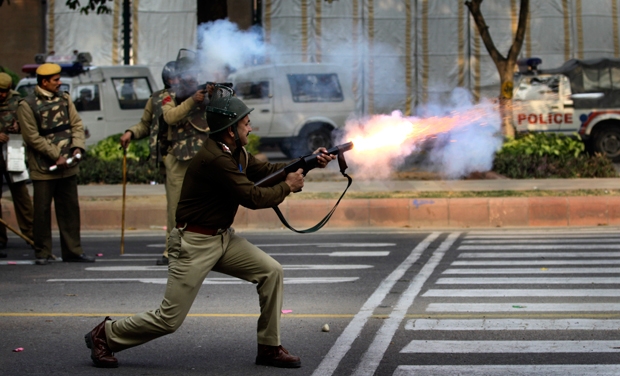
New Delhi, December 24: A month before the Republic turns up at India Gate, with all its pomp and glory, people incensed by its attempt to silence their voice marched all over the place, making a bonfire of the wooden barricades that keep them off Rajpath. The mild ones who advocated peace and didn't wish to stoke the fire were soon running for cover as the heavy hand of the state descended on them with round after round of tear gas and lathicharges.
Soon, India Gate was resembling a battleground with fires burning here and there, water on the ground and smoke in the air. But blood and bruises didn't deter the protesters and some of them were back at India Gate by nightfall, setting the stage for another day of uncertainty and confrontation on Monday.
What began as a peaceful protest on a misty Sunday morning gathered storm as the day progressed, ending with a massive clean-up operation by Delhi Police with tear gas, water cannons and lathicharge. There was chaos, anger and confusion as around 10,000 protesters and several cops clashed repeatedly. Police lathicharged the crowd at least 10 times, injuring 65 people (many more didn't report at hospitals). And finally, around 5.30pm, they just went berserk - the policemen and the Rapid Action Force rained lathi blows on everyone coming in their way, including protesters, mediapersons and even families out for a walk.
At least 250 tear gas shells were lobbed and water cannons used as cops chased the protesters all the way from India Gate to ITO, Mandi House and Pragati Maidan. Delhi Police officers said the protest, which was peaceful on Saturday, had been hijacked by some political elements and hooligans who threw stones at regular intervals. Around 78 policemen were injured, including one constable identified as Subhash Tomar who is reported to be critical. Officials said he was beaten up by the violent protestors and is now on ventilator support.
The drama began early in the morning as the protesters began to assemble around 8am. The cops imposed prohibitory orders under section 144 of CrPC in all of New Delhi area and tried sending the protesters to Jantar Mantar and Ramlila Maidan by dragging and pushing them into buses. However, many protesters successfully resisted this and the crowd steadily swelled. Parallel protests took place at 10 Janpath and Jantar Mantar. Even as Metro stations were closed down and barricades put up, people continued to pour into India Gate by walking long distances.
The cops had blocked all access routes early in the morning but there was no stopping the people. Unable to deal with a growing crowd that repeatedly made attempts to breach security, the cops fired tear gas and lathicharged the protesters repeatedly even as the agitators vandalised public property. The protesters were also lathicharged at Jantar Mantar, Rail Bhawan and Mansingh Road.
While a group of JNU students marched into India Gate from Nizamuddin around 11am, other groups made their way in from Ashoka Road. A large group of protesters blocked all traffic on the India Gate C-hexagon near Hyderabad House until cops removed them. Some rowdy elements in this group jumped on top of a police vehicle, breaking the windows and hammering the bonnet with sticks, even as others pleaded with them to stop, horrified. Some protesters gheraoed MP Sandeep Dikshit's car and chased him before he was escorted into the barricaded area of Rajpath.
A few protesters from the youth wing of left parties also tried making their way to Rashtrapati Bhavan through Rafi Marg. Around 200 youngsters, along with Brinda Karat, were forcefully pushed back near Rail Bhavan when the cops used their lathis and sprayed water to disperse the protesters around 12.30pm. But this did not deter the crowds. Women rights group like National Federation of India Women tried yet again to breach security leading to a second lathicharge within an hour.
"They think they will remove us from here but we will not go," said Sheela from Trilokpuri, who along with other women sat on the road causing the traffic to come to a standstill. After this these protesters started to make their way to Ashoka Road which was already reeling under a riot-like situation.
The violence sharply escalated around 5.15pm, with the protesters pelting stones at the police and burning barricades and machans. A Delhi Doordarshan SX4 vehicle was turned over and damaged by an angry mob. Around 5.30pm, Delhi Police ordered a lathicharge and evacuation of people from India Gate.
For the next one hour, the police went on the rampage, hitting anyone in sight, lobbing more than 200 tear gas shells and using water cannons. The protesters, who moved to the roads connecting the India Gate circle, damaged more than 50 vehicles, including 12 DTC buses, and set many vehicles, including a dozen PCR vans and some private vehicles, on fire. Even moving buses with passengers inside were pelted with stones.
Minutes before the lathicharge, special commissioner of police (law and order) Dharmendra Kumar blamed 'hooligans' for the violence, claiming that unruly elements had 'hijacked' the peaceful demonstration. Delhi Police in its report to the Union home ministry said that some 'vested interests' had joined the protesters and were instigating them.
Kumar disclosed that a former chief justice of India will constitute the commission of inquiry which will go into the gangrape incident, lapses by the police and measures to be taken to ensure safety of women in Delhi and other parts of the country.
Kumar also said that if the protesters remained peaceful, the police was willing to take a delegation to the home minister. "What is the purpose of this lawlessness? People should calm down and allow police to work," he added.





Comments
Add new comment